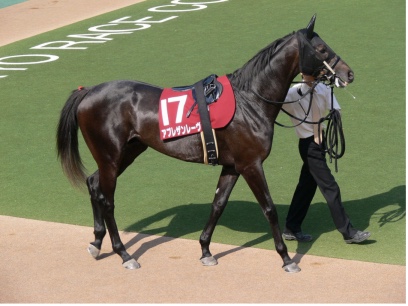A martingale is any equipment used to control head carriage in horses. Martingales can be found in various equestrian sports, including driving and riding. It is a type of horse equipment consisting of a strap, usually made of leather or nylon, affixed to the horse's headgear. The martingale ensures that the bit stays in contact with the mouth by constricting if pressure on the reins is eased. The standing and running martingales are used to control the horse's head height and prevent the horse from throwing its head so high that the rider is struck in the face by the horse's poll or upper neck. The martingale applies pressure to a horse's head as it rises above a certain height, making it more difficult or impossible to lift it higher.
A martingale is primarily used for control. It will not make a horse go faster, but it will slow them down if they increase speed. It will also be employed to keep the head up when desired, such as dressage. It's worth noting that many people misuse martingales, and it can cause problems, especially with horses who are sensitive to their mouths. Martingales are a type of horse tack most often seen in the equestrian world. They are most often used to prevent a horse from raising its head and throwing its head in the air. There are two major types of a martingale: The single-jointed or loose-jointed Martingale and the double-jointed or tight Martingale. The single-jointed Martingale uses one strap around the horse’s chest to attach to a noseband with two or three straps. The double-jointed Martingale uses a strap around the horse's chest, one strap going up over its neck and another waistband going down under its neck.
The standing martingale
A single strap is fastened to the perimeter, goes between the horse's front legs, and is fixed to the back of the noseband in the standing martingale, also known as a tiedown or head check. It also features a neck strap to keep it from catching on to other items. Instead of a neck strap, a version is attached to a breastplate. When set adequately for English riding, the martingale strap should be able to reach the horse's throat latch. A tie down is a version of the standing martingale that is virtually only seen in western riding disciplines. A tie down is adjusted much more quickly than a standing martingale, and it's designed to keep the horse's head from flying up when it's requested to halt or turn suddenly in a speed event. According to users, it also offers the horse something to hold against for balance. It comprises an adjustable strap with one end attached to the horse's breastplate and the harness’s noseband. The noseband can be made of leather, but it can be made of lariat rope or even plastic-covered cable, making the western tie down harsher than an English-style standing martingale.
When the horse raises its head above the desired point with both pieces of equipment, the slack is taken out of the strap, and pressure is applied to the horse's snout. The standing martingale is acceptable in the United States for show hunter and hunts seat equitation riders over fences, in the United Kingdom for show jumping competitions, and fox hunting, polo crosse, horse ball, and polo. It's also seen on some military and police horses, partly for fashion and tradition, but also in the event of an emergency that requires the rider to react quickly. It is not permitted in flat classes.
Safety and risks
Because it cannot be loosened in an emergency, the standing martingale is more restricted than the running martingale. Because its range of motion is limited, a horse that trips in a standing martingale may fall more easily. If a horse falls while wearing an inappropriately fitted standing martingale, it will be unable to stretch its neck entirely and have difficulty getting back up more challenging.The martingale strap is never fastened to a drop noseband due to the risk of harm to the nose cartilage. It should also not be attached to any form of figure 8 or grackle noseband due to the risk of both nose and jaw damage.
When used in conjunction with other pieces of equipment, any martingale can cause pain to the horse. When used in conjunction with a gag bit, a standing martingale can trap the horse's head, forcing it to raise and lower its head while providing no relief in either direction. This combination can be seen in polo, some rodeo events, and even the lower jumping levels on occasion. Overuse or misuse can cause the muscles on the bottom of the neck to overdevelop, resulting in an unfavourable upside-down neck that makes it more difficult for the horse to work correctly under the saddle. It can also cause the horse's back muscles to tense up and force him to move awkwardly, especially over fences. This can place too much strain on the horse's spine, diminish the limb anatomy's shock-absorbing capacity, and eventually lead to lameness. Accidents are also a possibility: if a horse is sufficiently "caught" by a combination of a too-short martingale and a too-harsh bit, the horse may attempt to rear and fall, potentially harming both the animal and the rider.








